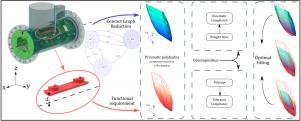Computer-Aided Design ( IF 4.3 ) Pub Date : 2021-07-05 , DOI: 10.1016/j.cad.2021.103071 Vincent Delos 1 , Denis Teissandier 2 , Alexander Malyshev 3 , Grégory Nuel 4 , Sonia C. García 2

|
The cumulative stack-up of geometric variations in mechanical systems can be modeled summing and intersecting sets of constraints. These constraints derive from tolerance zones or from contact restrictions between parts. The advantage of this approach is its robustness for treating any kind of mechanisms, including the over-constrained ones. However, the sum of constraints, which must be computed when simulating the accumulation of defects in serial joints, is a very time-consuming operation. In previous papers, we proposed to virtually limit the degrees of freedom of the toleranced features and joints turning the polyhedra into polytopes to avoid manipulating unbounded objects. Even though this approach enables to process the whole mechanism, it also introduces bounding or cap facets which increase the complexity of the operand sets after each operation until becoming far too significant. In this work, we introduce algorithms summing, intersecting and testing inclusions. As they operate on sets of constraints using unbounded polyhedral objects, we identify the smaller sub-space in which the projection of these operands are bounded sets. Calculating the sum in this sub-space allows reducing the operands complexity significantly and consequently the computational time. Then, checking the final inclusion informs us not only about the compliance of the mechanism tolerances with respect to the functional specification but also to quantify how far we are from this target. Finally prismatic polyhedra integrate ISO and contacts specifications in a very natural way and are able to perform a full kinematic analysis of the mechanism. After presenting the geometric properties on which this approach rely, we demonstrate it on an industrial case. Then we compare the computation times, prove the robustness of the new method and show how to quantify the functional condition compliance with respect to a given set of tolerances.
中文翻译:

用于公差分析的基于多面体的建模和算法
机械系统中几何变化的累积叠加可以建模为总和和交叉约束集。这些约束源自公差带或零件之间的接触限制。这种方法的优点是它对处理任何类型的机制的鲁棒性,包括过度约束的机制。然而,在模拟串行接头中的缺陷累积时必须计算约束总和是一项非常耗时的操作。在之前的论文中,我们建议虚拟限制公差特征和关节的自由度,将多面体变成多面体,以避免操纵无界物体。即使这种方法能够处理整个机制,它还引入了边界或上限方面,这会在每次操作后增加操作数集的复杂性,直到变得过于重要。在这项工作中,我们介绍了求和、相交和测试包含的算法。当它们使用无界多面体对象对约束集进行操作时,我们确定了较小的子空间,其中这些操作数的投影是有界集。计算该子空间中的总和可以显着降低操作数的复杂性,从而减少计算时间。然后,检查最终包含的内容不仅可以告知我们关于功能规范的机制公差的合规性,还可以量化我们离这个目标还有多远。最后,棱柱多面体以非常自然的方式集成了 ISO 和接触规范,并且能够对机构进行完整的运动学分析。在介绍了这种方法所依赖的几何特性之后,我们在一个工业案例中对其进行了演示。然后我们比较计算时间,证明新方法的鲁棒性,并展示如何根据一组给定的容差量化功能条件的符合性。


























 京公网安备 11010802027423号
京公网安备 11010802027423号